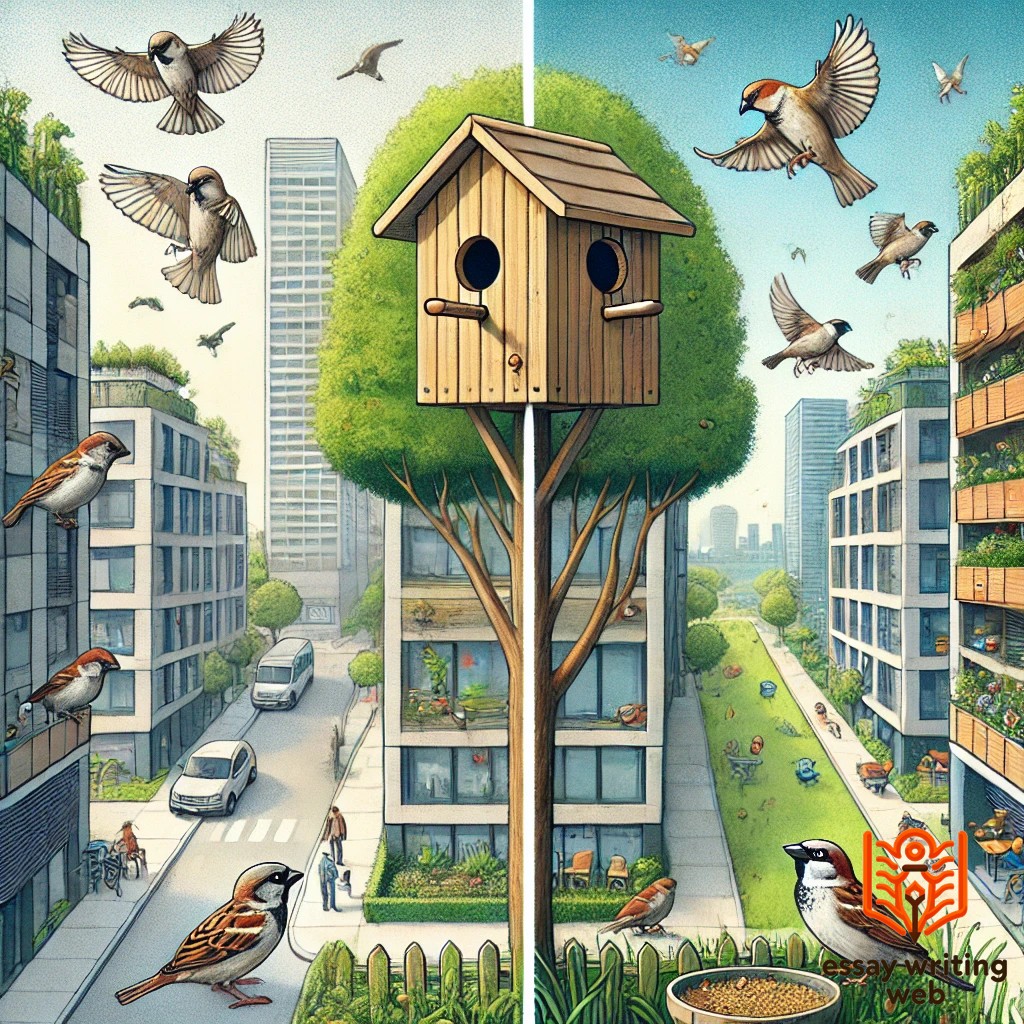 Essay Writing Web
Essay Writing Web

 19-09-2024
19-09-2024
 www.essaywritingweb.com
www.essaywritingweb.com
The House Sparrow is a small, familiar bird that has adapted well to living in close proximity to humans. Found in cities, towns, and rural areas across the world, the House Sparrow is one of the most widespread bird species on the planet. Native to Europe, Asia, and parts of North Africa, it has now been introduced to many other regions, including the Americas, Australia, and New Zealand. Despite its common presence, this resilient species has a fascinating history and plays a significant role in both ecosystems and human culture.
House Sparrows are easily recognizable by their compact bodies, short wings, and sturdy beaks. The males typically have a grey crown with black around their eyes and throat, while the females are less distinct, with more uniform brown and grey coloring. These birds are highly social, often seen in flocks, and are known for their noisy, chattering behavior. They have a strong affinity for urban environments, frequently nesting in buildings, rooftops, and other human-made structures.
One of the key reasons for the success of House Sparrows is their adaptability. They have a varied diet, feeding on seeds, grains, and insects, which allows them to thrive in both natural and urban settings. However, in recent years, the House Sparrow population has seen a decline in some parts of the world, particularly in urbanized regions. This decline has raised concerns among conservationists, leading to research on the causes, such as habitat loss, changes in food availability, and increased pollution.
Despite these challenges, the House Sparrow remains a symbol of resilience. Its presence in human settlements for centuries has made it an integral part of the landscape, and it continues to be a beloved bird around the world.
The House Sparrow is a small, robust bird with distinct physical characteristics that make it easily identifiable. Measuring around 14 to 16 centimeters in length and weighing approximately 24 to 40 grams, this species has a compact body, short tail, and strong, conical beak perfectly adapted for eating seeds. The wings are relatively short, giving the bird a quick, fluttering flight pattern, but they allow for agile movements in urban and natural environments alike.
One of the most noticeable differences between male and female House Sparrows is their plumage. Males typically have a more striking appearance with a grey crown, white cheeks, and a distinctive black bib or throat patch. Their back and wings are streaked with shades of brown, rust, and black, adding to their vivid contrast. Females, on the other hand, are less colorful, featuring a more subdued mix of brown, grey, and buff tones, which helps them blend into their surroundings, particularly when nesting.
The sturdy, cone-shaped beak of the House Sparrow is a key characteristic, enabling it to easily crack open seeds and grains, which form a large part of its diet. Their legs and feet are strong, aiding in perching and hopping across various surfaces. Despite their small size, House Sparrows are remarkably resilient and adaptable birds, capable of thriving in a wide range of climates and environments. Their physical attributes, combined with their social nature, make them one of the most familiar bird species worldwide.
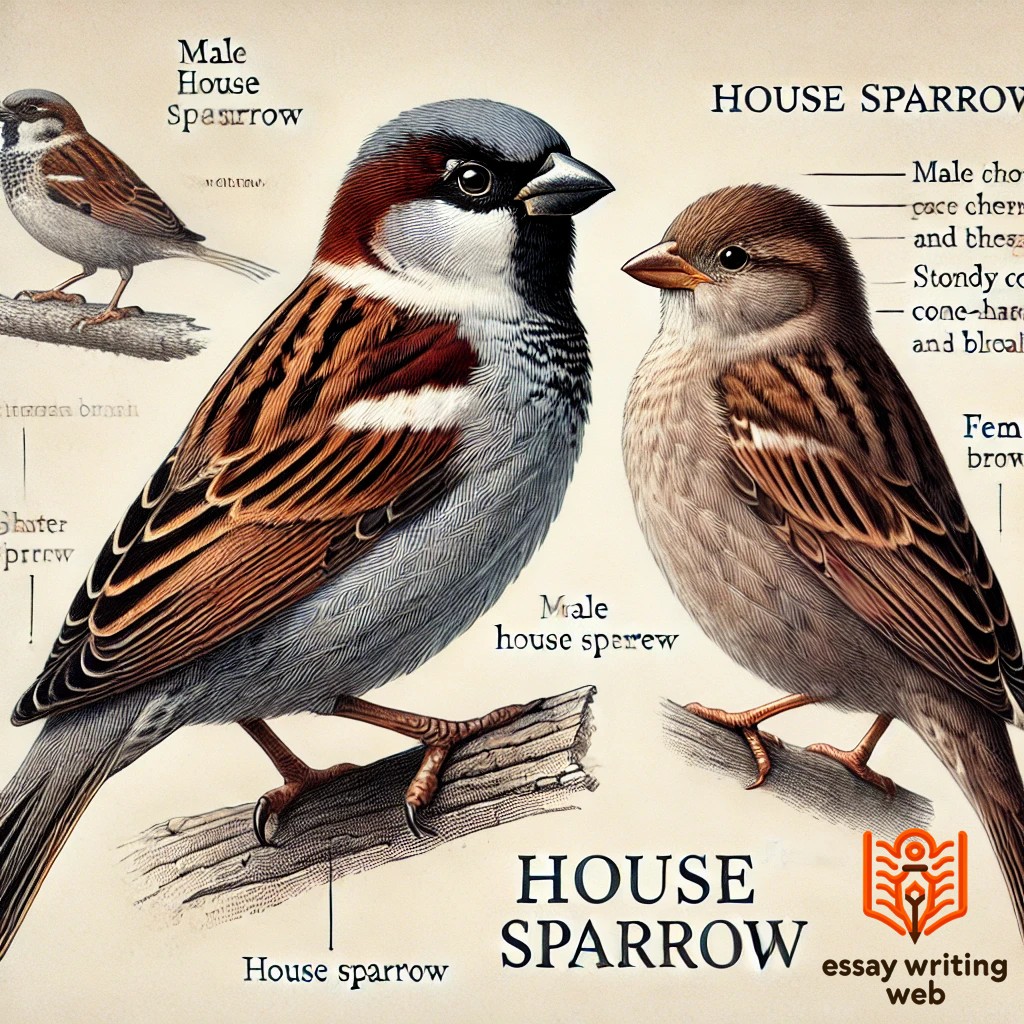
The House Sparrow is an incredibly adaptable bird, thriving in a wide range of habitats across the globe. Originally native to Europe, Asia, and parts of North Africa, this small bird has successfully spread to many other regions, including the Americas, Australia, and New Zealand, following human settlements. Its ability to coexist with humans has made it a common sight in urban and rural environments.
House Sparrows are typically found near human habitation, preferring areas where food is readily available. They often inhabit cities, towns, farms, and gardens, taking advantage of the abundance of seeds, grains, and scraps from human activities. Their nests can be found in various locations, including building crevices, rooftops, and even traffic lights, as well as in trees and shrubs when living in more natural settings.
Although House Sparrows are most commonly associated with urban environments, they are also found in rural areas, especially around farms where food sources are plentiful. Despite their remarkable adaptability, the population of House Sparrows has been declining in some regions due to factors like habitat loss, pollution, and reduced food availability. Nevertheless, they remain one of the most widespread and recognizable bird species, continuing to thrive in diverse environments globally.

The House Sparrow is an opportunistic feeder with a highly adaptable diet, allowing it to thrive in diverse environments. Primarily granivorous, its diet mainly consists of seeds and grains, making it a frequent visitor to agricultural fields and urban areas where food sources are abundant. House Sparrows commonly feed on millet, oats, wheat, and various weed seeds, making them well-suited to living near farms and gardens.
In addition to seeds, House Sparrows also consume a variety of other food sources depending on availability. During the breeding season, they actively hunt insects like beetles, caterpillars, and flies, which provide essential protein for growing chicks. They are known to forage on the ground, hopping from place to place in search of food.
In urban environments, House Sparrows have adapted to feed on human food scraps, breadcrumbs, and even pet food. Their ability to find food in different settings, whether natural or human-made, is a testament to their resilience. However, their dependence on human-related food sources in cities can sometimes expose them to risks like poor nutrition or toxins from polluted environments.
This adaptability in diet has been one of the key factors in the House Sparrow’s widespread success across the globe.
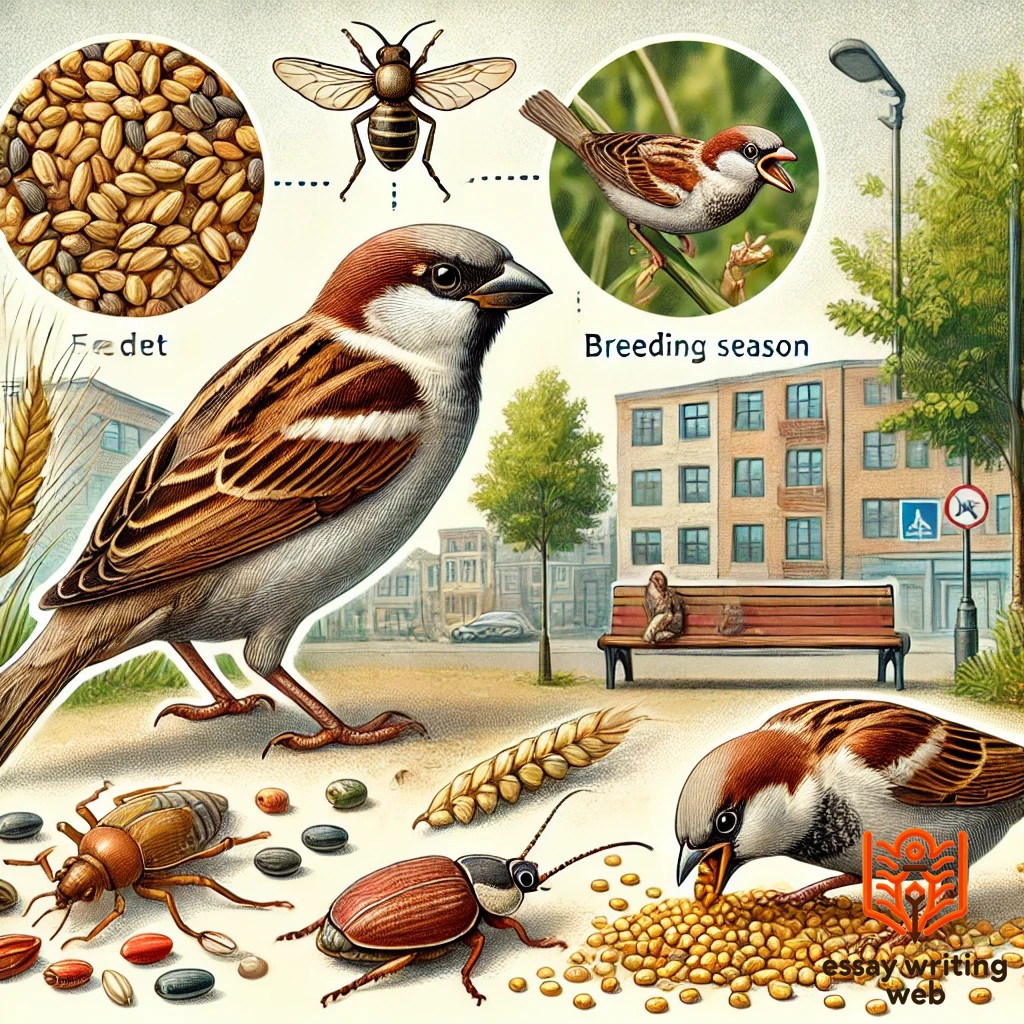
The House Sparrow is a highly social and interactive bird, known for its lively behavior and strong communal bonds. These small birds are often found in flocks, moving together in search of food or shelter. Their social nature is especially visible during feeding, where they can be seen chattering and hopping around each other, displaying a variety of vocalizations and interactions.
House Sparrows communicate through a series of chirps and calls, with males being particularly vocal to defend their territory and attract mates. They are territorial birds, especially during the breeding season, when males aggressively protect their nesting sites from potential rivals.
In terms of social structure, House Sparrows exhibit a hierarchical system within their flocks. Dominant males often secure the best nesting locations and food sources, while others follow a pecking order. Despite this hierarchy, they are highly cooperative, often nesting in close proximity to one another, sharing feeding areas, and even roosting together in large groups for warmth and safety.
Their communal behavior also extends to raising their young, as both males and females take part in feeding and protecting their offspring. This strong social structure and adaptive behavior have contributed significantly to the House Sparrow's survival and widespread distribution across diverse environments.
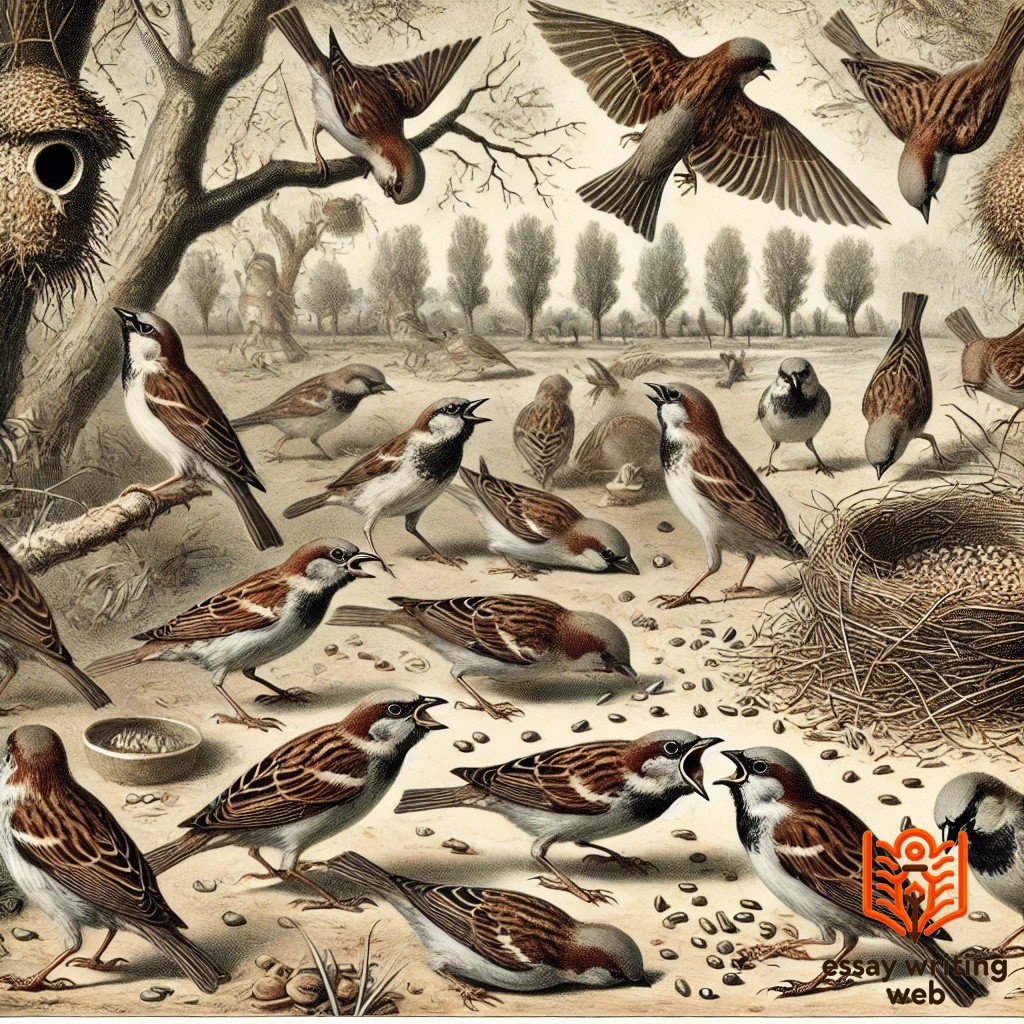
The House Sparrow exhibits remarkable adaptability in its nesting and reproduction habits, which contribute to its widespread success. House Sparrows typically build their nests in close proximity to human settlements, taking advantage of sheltered spaces such as building crevices, rooftops, gutters, and even streetlights. In rural settings, they often nest in trees, shrubs, or birdhouses. Their nests are made of a variety of materials, including grass, straw, feathers, paper, and even string, forming a compact structure to protect their eggs and young.
House Sparrows are monogamous, with pairs often mating for life. During the breeding season, which occurs between March and August, females typically lay 3 to 5 eggs per clutch. The eggs are small, white, and speckled, and both the male and female share responsibilities for incubating them over a period of 10 to 14 days.
Once hatched, the young sparrows, called chicks, are fed by both parents, primarily with insects that provide the necessary protein for rapid growth. The chicks fledge, or leave the nest, after about two weeks, though they may continue to rely on their parents for food and protection for a short period. House Sparrows can raise multiple broods in a single breeding season, further increasing their population. This reproductive strategy plays a key role in their survival and adaptation to various environments.

The House Sparrow is known for its versatility when it comes to choosing nesting locations, allowing it to thrive in a variety of environments. Unlike many other bird species, House Sparrows are not particularly selective about where they build their nests, which can be found in both urban and rural settings. Their nests are often constructed in crevices, cavities, and sheltered spaces close to human habitation.
In urban areas, House Sparrows commonly nest in building structures, such as cracks in walls, under roof tiles, or inside gutters. They may also utilize man-made structures like streetlights, signboards, and even traffic lights as nesting sites. These locations provide the birds with safety from predators and easy access to food sources.
In more rural settings, House Sparrows often nest in trees, bushes, or birdhouses. On farms, they may build nests in barns, sheds, or under eaves. Their adaptability allows them to make use of almost any available nook or cranny.
Their nests, made from grass, twigs, feathers, and other soft materials, are built in these sheltered locations to protect their eggs and young from the elements and predators. This flexibility in nesting site selection has been a significant factor in the House Sparrow’s ability to coexist with humans and spread globally.
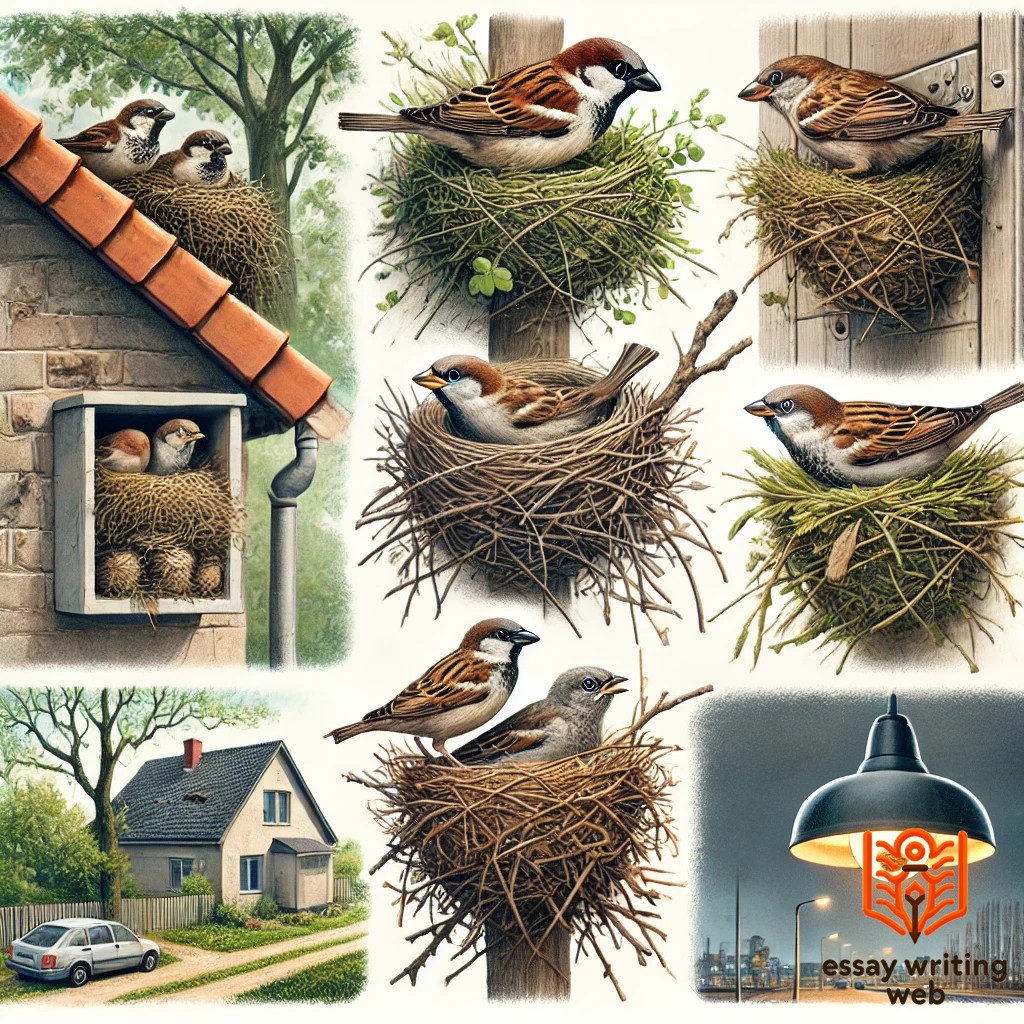
The House Sparrow has had a long-standing relationship with humans, thriving in both urban and rural environments. These small birds have adapted to living in close proximity to human settlements, making them one of the most familiar bird species worldwide. Over centuries, House Sparrows have come to rely on humans for food and shelter, nesting in man-made structures like buildings, rooftops, and gutters.
In urban areas, House Sparrows are often seen feeding on food scraps, seeds, and grains discarded by people. They have become a common sight in parks, gardens, and public spaces, where they can forage easily. Their adaptability to human-altered landscapes has contributed to their widespread presence across cities and towns.
However, this relationship has not always been entirely beneficial. In some agricultural areas, House Sparrows are considered pests for consuming crops and grains. Yet, they also play a positive role by feeding on insects, particularly during the breeding season, which helps control pest populations.
In recent years, House Sparrows have faced declining populations in certain regions, leading to concern among conservationists. Urbanization, pollution, and changes in food availability have contributed to this decline, prompting efforts to preserve habitats and raise awareness about their importance in the ecosystem. Despite these challenges, the House Sparrow remains a symbol of coexistence between humans and wildlife.
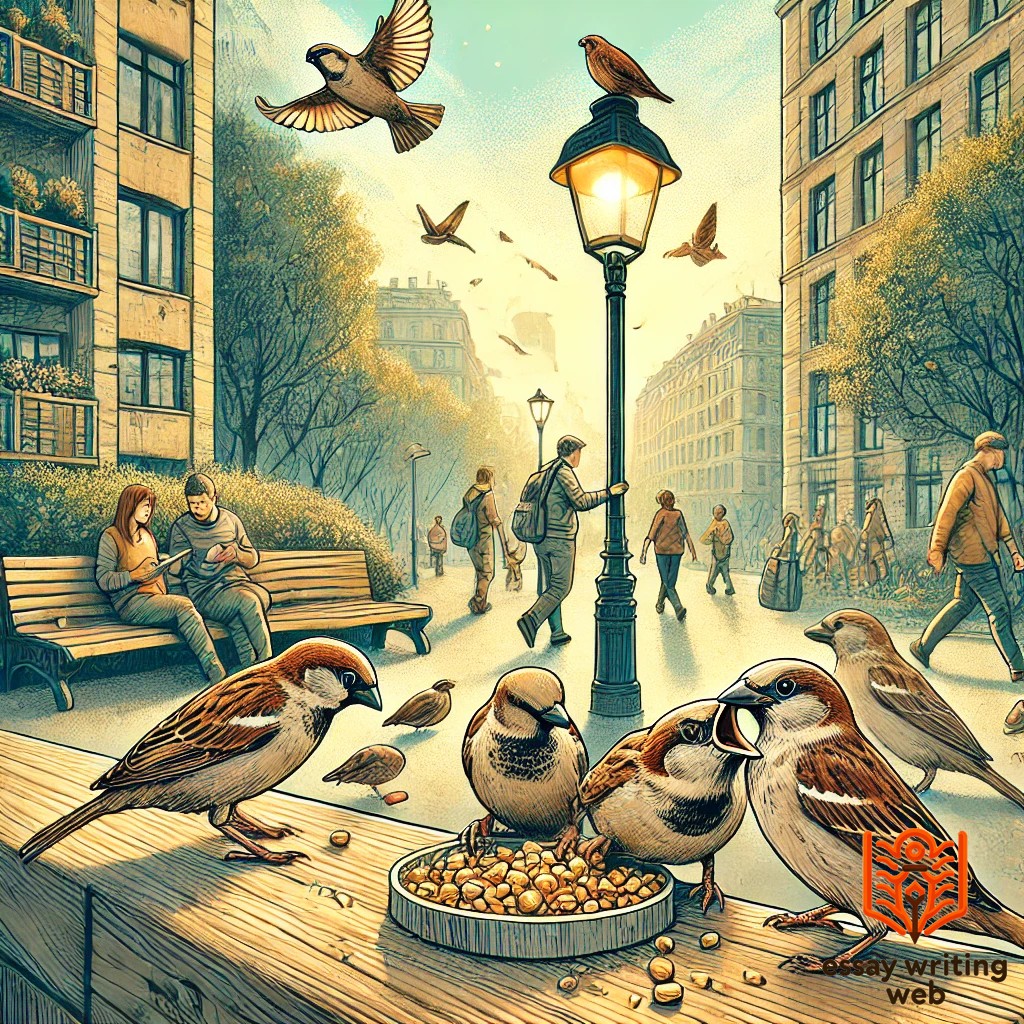
The House Sparrow has demonstrated remarkable adaptability in living around humans, thriving in urban and rural environments across the world. One of the primary ways sparrows have adapted is through their ability to utilize human-made structures for nesting. Instead of relying solely on trees or natural cavities, sparrows commonly build their nests in crevices of buildings, rooftops, streetlights, and other urban structures, taking advantage of the shelter and protection these places provide.
Their diet flexibility is another key adaptation. While sparrows primarily feed on seeds and grains, they have adjusted to consume food scraps discarded by humans. In cities and towns, they can often be seen foraging in parks, streets, and public spaces, making the most of the food waste from human activity. This opportunistic feeding behavior has allowed them to survive in areas where natural food sources are limited.
Sparrows have also adapted their behavior to navigate busy urban environments. They are less wary of human presence compared to other bird species, which helps them thrive in densely populated areas. This tolerance for noise, movement, and human interaction has enabled sparrows to become one of the most common bird species in human settlements, reflecting their impressive resilience and adaptability to modern life.
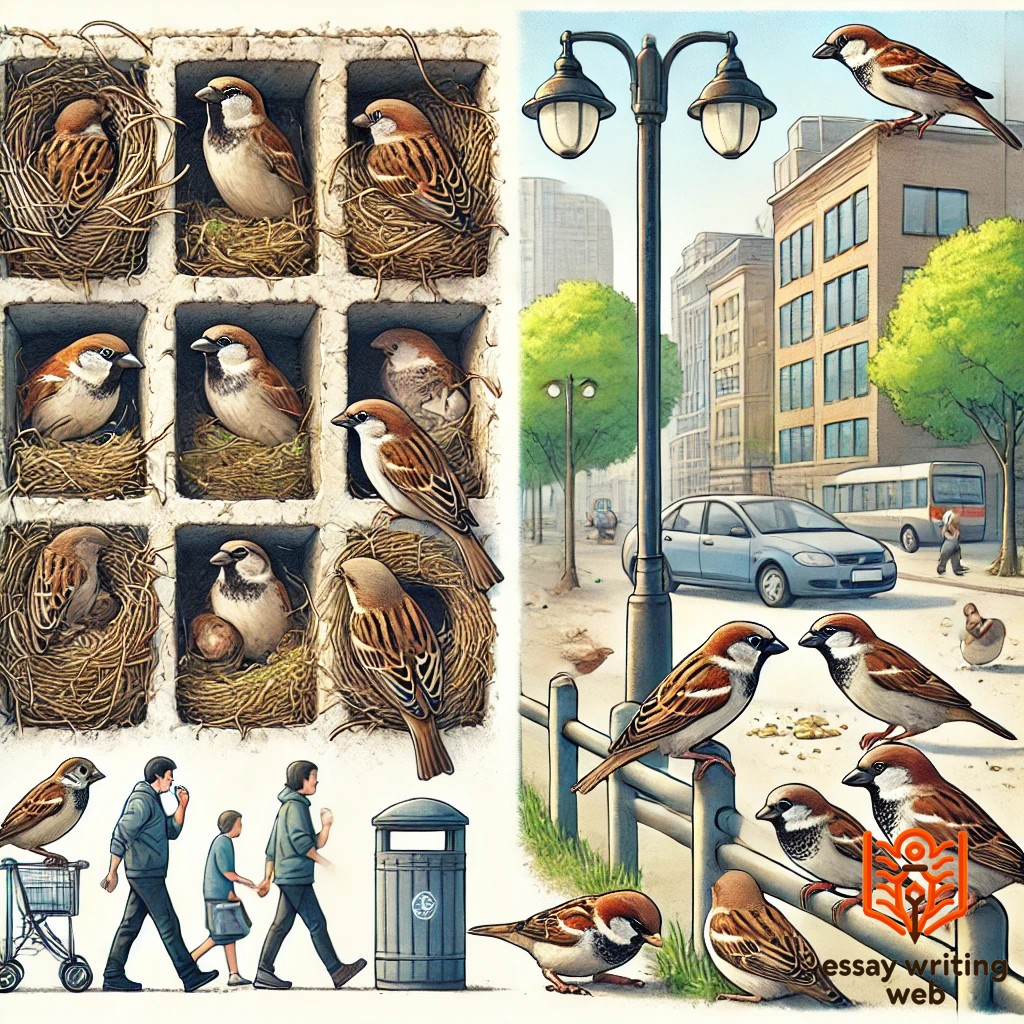
The House Sparrow, once a ubiquitous bird species, has seen a notable decline in population in various regions, leading to concerns about its conservation status. While the species is still classified as "Least Concern" by the International Union for Conservation of Nature (IUCN), localized declines, especially in urban areas, have raised alarms. In countries like the United Kingdom and India, House Sparrow populations have decreased dramatically in recent decades.
Several factors have contributed to this decline. One of the primary causes is urbanization, which leads to the loss of suitable nesting sites as modern buildings offer fewer crevices and spaces for sparrows to nest. Additionally, the decline in insect populations, particularly in urban areas, has affected their food supply, especially for feeding chicks, which rely heavily on insects in their early stages of development. Increased pollution and the widespread use of pesticides have also negatively impacted their survival.
Conservation efforts are underway in various parts of the world to address this issue. In some areas, initiatives encourage people to install birdhouses or sparrow-friendly nesting sites in urban settings. Raising awareness about the importance of preserving green spaces and reducing pesticide use can also play a significant role in safeguarding the future of the House Sparrow.
